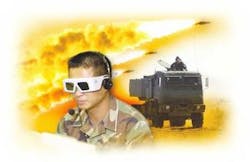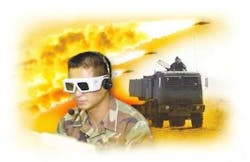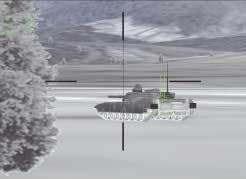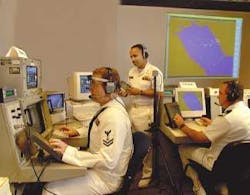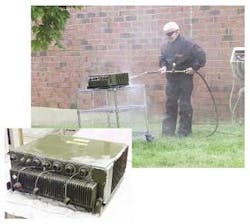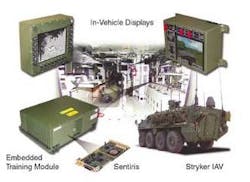By J.R. Wilson
Networking and artificial intelligence work together to blur the lines between military training in the real world and simulated training at the computer, as new technologies help make practicing military skills more realistic and cost-effective than ever before.
The Pentagon's concept of a smaller, lighter, faster, and more mobile "Objective Force" will work in the global war on terrorism only if the entire force including Reserve and National Guard units maintain a constant state of peak readiness. Given the large amount of money and time involved with transporting troops and equipment to centralized training centers, and the limited duty time of nonmobilized Guard and Reserve units, that will require a significant investment in, and commitment to, home-based simulation and embedded training.
The level of importance that U.S. Department of Defense (DOD) leaders assign to this perhaps best reflects in one DOD declaration: training, for the first time, is one of the seven key performance parameters that the evolving Future Combat System (FCS), as well as 18 manned and unmanned vehicles, must meet before their scheduled fielding by 2010. The key to that is embedded training, according to the Army's Training and Doctrine Command (TRADOC) at Fort Monroe, Va.
"Ideally, we want to take the training to the soldier instead of the soldier to the training. Training happens three ways: the institutional piece, the deployed piece, and the combat training centers," says Mike Kelley, TRADOC's deputy systems manager for FCS.
"We want to have the soldier, including leaders and staff, able to access individual MOS [military occupational specialty training], then move it on to collective training. We want all that resident on the platform or available through the C4ISR (command, control, communications, computers, intelligence, surveillance and reconnaissance) network." In the future, some training will still occur at institutions, but it will not be as prevalent as it is today, Kelley says.
In-place training
How military leaders will accomplish in-place training will vary from platform to platform, and service to service. Some in-place training will be embedded within new platforms, such as FCS, while others either will be partially embedded, umbilical, or appended — or a training device that can be temporarily inserted into the platform. Some will be a combination of live action and virtual reality.
One example of combining live action and virtual reality evolved from the Navy's sudden loss of access to its primary Atlantic live-fire range on the Puerto Rican island of Vieques. To have its big gun crews properly trained to aim and fire in combat, the Office of Naval Research (ONR) had to move quickly in 2002-2003 to develop a combination of virtual, live, and constructive simulation. They created the Virtual At-Sea Training (VAST) system enabled ship guns, Marine long-range artillery, submarine fire, or aircraft bombing runs with either real or simulated weapons to engage real or synthetic targets.
Some elements of VAST use technologies that ONR has developed as part of the Advanced Embedded Training initiative.
ONR has had several programs involved with distributed and embedded training. The Navy's advanced distributed training program looked at ways to help sailors aboard Arleigh Burke–class destroyers identify incoming enemy aircraft and missiles, says Ray Perez, ONR's science officer for training.
Some programs have tried to use artificial intelligence (AI) technology to help automated embedded training tasks. "Early embedded training required an instructor stand over the trainee to provide feedback. The instructor had to manipulate, by hand, the various elements in each scenario," Perez says. "More advanced systems now use AI that automatically tracks the trainee's performance and provides feedback, diagnoses errors and assigns appropriate remedial practice.
VAST takes the lead
VAST takes this trend a step further. "Sensors will be located in the ocean to indicate how close they came to the target," Perez says. "They will shoot live shells, but at open ocean, while seeing the simulated land target through their displays. That is currently in proof-of-concept, but it's a fast-moving program and I believe the goal is to have it deployed to the fleet sometime in 2004."
VAST program manager Harold Hawkins says the same kinds of technologies are expanding to other applications, including joint-service blending of the real and the synthetic. One now under development, the JOU.S.T program (Joint Operations in Urban Synthetic Terrain) will link the Army's McKenna MOUT (military operations in urban terrain) site at Fort Benning, Ga., the Navy's Dahlgren, Va., gunnery range, and the Air Force Theater Air Command and Control Simulation Facility in New Mexico. The result will be real-time common images of activities involving all three services attacking targets in and around city streets, with live soldiers moving through the buildings at McKenna, live naval fire at Dahlgren, and synthetic fire elsewhere.
"What they see on their screens is a virtual representation of a real location in the Far East, from different perspectives," Hawkins says. The first demonstration, funded by the Defense Modeling and Simulation Office (DMSO), took place in November 2003. "A virtual UAV observes the impact of Navy munitions on the synthetic site and reports the effect of those detonations, influencing what the three services do next." No aircraft are involved at this stage, but may be in the future.
Based on VAST, officials are starting a new system for the Marines at Camp Lejune, N.C., that will use live or constructed fire to train troops on new long-range weapons systems. The most significant of these is HIMARS — short for high-mobility artillery rocket system—which can fire several rockets across long distances, Hawkins says. The ability to practice and receive feedback on the accuracy of their aim is of tremendous value to the Marines, he says.
Active feedback
"That also has implications for the Army, which has analogous systems," Hawkins continues. "We can provide very active feedback, even with constructive rounds, because we have high-fidelity weapons information. That enables both the Army and Air Force to do a lot of training on the cheap. These shells are very expensive and it is becoming more and more difficult to find ranges."
Another major concern with such training, especially for the U.S. Pacific fleet, is antisubmarine warfare (ASW). ONR officials are developing an aviation-based ASW version of VAST to help the Navy train ASW forces in aircraft, surface ships, and submarines something they something it currently cannot accomplish.
Human sonar operators will practice the communications and coordination necesary to run the gamut of activities, from search, to attack, and re-attack, Hawkins says. "Every single node in the battle group/air ASW communities will be involved, with real people playing the role of the threat or an intelligent computerized entity. The computer can also play any other member of the group involved in the scenarios."
The significance of computer-generated forces is the flexibility it offers. "You don't need everyone in place to train the rest," Hawkins says. "This is a tremendous cost savings and a flexibility-related addition." ONR officials also are working two related aviation systems — a joint Navy/Air Force Tactical Combat Training System (TCTS) and the Navy Fleet Aircrew Simulation Training (FAST) system.
TCTS involves developing a pod to put on a fighter aircraft wing to provide communication links between the cockpit and ground stations running a synthetic threat environment. The pods can communicate target information to the aircraft weapons systems and fire ordnance into the water that other systems see as real targets in a synthetic battlespace. The aircraft simulations also can link to simulators on the ground, which represent other parts of the ASW package.
Networked simulation
FAST will use state-of-the-art simulators representing F/A-18s jet fighter-bombers, P-3 maritime patrol turboprops, and other ASW components. While those normally are ground-based systems, ONR officials are looking at the possibility of putting some simulators aboard ships, which will link to live aircraft via a common synthetic battlespace. That battlespace also will include live and simulated surface and subsurface elements portraying enemy forces.
"We can do this very quickly because we have about 25 years of experience in computer generation, simulation, combat training, and so on that we can draw on," Hawkins says. "Within months of being asked to deliver a system, we will be able to deliver, which is unheard of in the military. Computer power is not an issue, but bandwidth is, because it limits what information we can port from one location to another in real time, Hawkins explains.
While the Army is looking at embedding training in new weapons, the Air Force and Navy will rely heavily on external simulators and on a VAST-like synthetic mix. Every training concept must work together across great distances to provide the kind of future joint exercise capability that Pentagon leaders see as vital to keeping fighting skills sharp.
Officials of the U.S. Defense Advanced Research Projects Agency (DARPA) in Arlington, Va., are sponsoring one, called DARPA Wars, in which participants from all three services plan and will fight that war together using networked distributed training with dedicated simulators, laptops and PCs, as well as actual weapon systems.
One challenge is to build computer-controlled simulated forces sophisticated enough to simulate human behavior. "If they are too perfect, no one learns from them; if they are too imperfect, the same problem arises," Perez says. "Driving those enemy forces is a tough technical problem. When a military officer is fighting an enemy, he has to believe that enemy is real or he won't really learn."
Mission rehearsal
By raising the level of realism, advanced embedded training also makes it possible to plan and practice realistically for actual combat operations.
Military officials want to practice real-world missions through a networked mission-rehearsal system to train collectively from platoon through the brigade level, using the terrain, enemy, and all battle elements, Perez explains. "It won't be a perfect world. Not all those pieces are there, but that is the goal."
That, he says, is why embedded training is such a powerful idea. "Because we are building this system from the ground up, embedded training and its components and requirements for information and data will be designed into the platform," Perez says. More difficult and expensive will be bringing existing platforms into the equation once FCS is fielded.
"That's a challenge, to get this capability and re-engineer it back into current and Stryker forces," Kelly acknowledges. Military officials are trying to install embedded training into the Army's M1 Abrams main battle tank and M2 Bradley Fighting Vehicle.
Established training practices
While embedded training and networked simulations will make intensive training and mission rehearsal a daily possibility no matter where an individual, platoon, brigade or corps may be, military planners are quick to note that embedded training will not make the big training centers at Fort Irwin, Fort Polk, and elsewhere obsolete. In many ways, it will make them even more important and valuable.
"We can do all the embedded training in the world, but at some point we must go out and do it in a live environment to make sure you've got it right," Kelley says. The combination of embedded training, virtual reality, and a sophisticated C4ISR network opens up new possibilities to prepare units still at their continental U.S. bases for even the most alien terrain and circumstances.
Through the C4ISR system and requisite security, a unit in the United States could observe actual operations of a deployed unit and use that as professional development, training, and education. "That's a powerful idea," Kelley says. "I'm watching the unit I'm going to replace, day to day, and using that to prepare my soldiers and staff for that duty. The idea is the system has the ability to record a battle as it is being prosecuted."
One concern raised in the early conceptual days of embedded training was the possibility of mistaking a live element for a simulated element.
"We are looking for a seamless replication of the operational environment in a training environment. While a soldier won't be firing real rounds in a training mode, he may be activating some turret mechanisms that give him the same feedback," says Tim Ward, project director for Future Force Simulation at the Program Executive Office for Simulation, Training & Instrumentation in Orlando, Fla.
